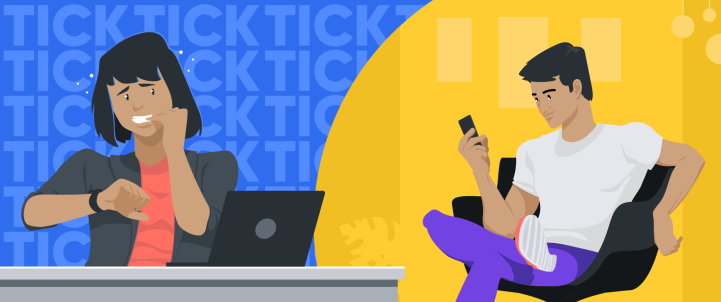So you want to set up a campaign that helps celebrate a new user launching your exercise app for the first time. Or you have a food app and you want to make sure that your users don’t log off without actually completing a food purchase. How do you do it?
Every mobile marketing tool has a feature that allows you to schedule and trigger campaigns based on in-app actions that your users take (or choose not to take). Here, we take a look at some basic mistakes that marketers make using these campaigns.
Why Use Scheduled and Triggered Campaigns?
Scheduled campaigns let you send communication at a designated time based on your user’s past behavior. Triggered campaigns allow you to create a series of messages or promotions that will go out as soon as a user performs a specific action. Triggered campaigns can also go out when a user fails to perform an action that you want them to accomplish.
These campaigns, paired with contextual notifications that are pre-written and sent at the right time result in highly personalized communication with your user.
For your exercise app, you could choose to send a congratulatory push notification either:
- A. One day after a user first launches your exercise app, or
- B. Immediately after a user completes their first workout.
In the food app example, you can send a gentle in-app notification to the user who’s had your app open for 15 minutes but hasn’t ordered anything. Include a discount or promo to entice the user to buy.
Sounds pretty straightforward, right? Except, you have to be careful how you use these campaigns. Don’t abuse them, or they may spoil the user experience for your customers.
Don’t Make These 5 Mistakes with Scheduled and Triggered Campaigns
1. Immediately sending a push notification upon launch
Have you set up a triggered campaign to send a push as soon as your app is launched? If so, please reconsider. It’s a heavily intrusive move that may actually dissuade your users from further engaging with your app — they’re too distracted trying to read your notification!
You want your messages to deliver value as part of a larger user experience. Plus, you want the entire experience to be delightful, not distracting or intrusive.
If you absolutely feel it’s a missed opportunity to communicate, then you’re better off sending an in-app notification upon app launch, not a push which will take them out of your app to read.
2. Too short a gap between action and inaction
Another annoying campaign is when an app suddenly decides the user is inactive and then the marketing messages come across as desperate — demanding that the user return or that the brand misses them.
We’ve all experienced this: adding an item to a shopping cart, and within one minute, the system floods the device with messages like, “Left something in the cart?” or “Haven’t found anything yet?”
This happens when you’ve set too short a gap between the last action and the system declaring the user “inactive.”
Give your users some space. Be realistic with your time estimates. And don’t just use gut instinct, use data to inform the timing. Do a proper funnel analysis to help you identify how long the average user takes to get to a conversion point, then use that data as the baseline.
For example: according to our industry benchmark report, 80% of travel apps users perform a search and move on to the engagement stage within 44 minutes. If you’re sending out triggered campaigns before users have had those first 44 minutes to see the value of your app, then you’re actually detracting from the user experience. In fact, you could be sabotaging your users from converting!
3. Spamming them to kingdom come
The temptation with any kind of marketing automation is to overdo it. With mobile campaigns, you may have way too many trigger activities set up so that it floods a user’s lock screen, app inbox, or email inbox.
As with anything in life, the key is moderation. Keep tight control over the number of triggers you have active at any one point in time so that a particularly active user isn’t inundated by your messaging.
Better yet, check the safeguards you have set up. CleverTap’s Triggered and Scheduled Campaigns have a Global Setting to ensure that users only receive X number of push messages every Y days. And this can be set up for every communication channel (push, in-app, email, social, etc.). Use this feature to avoid bombarding your users!
4. Forgetting the time of day
Ever have your phone buzz at 1:00 AM only to find a flash sale notice from a travel app? So much for trying to sleep.
Ideally, you don’t want to send campaigns when a user may be sleeping (or when they’re focused on other things). You want them alert, or bored, ready to absorb your effective mobile copywriting.
Unfortunately, mobile marketers may be a world away from their users and not everyone has intelligent marketing automation tools to remind them that the time is not right for specific users.
Which is why you should set up DND (Do Not Disturb) times for your users so you don’t accidentally schedule a promotional campaign to go out in the middle of the night.
5. Too much data collection
The goal of all effective mobile marketing is to send customers personalized messaging. And as marketers, we have the technology to get a wide array of information on users. But there is a fine line between collecting enough data so marketing can be more customized, and collecting so much data that marketing ends up being plain creepy.
Just because you CAN collect (or infer) a user’s demographics, technographics, psychographics, and geolocation doesn’t mean you SHOULD.
You don’t want your campaigns to end up becoming creepy, intrusive, or voyeuristic. Stick with just enough data to get personable, but not so much that they’re looking over their shoulder.
The Point is to Delight
In the end, triggered and scheduled campaigns are a powerful feature that let you respond in real time to your users’ behavior and even send strategic prompts to guide them into your funnel. Just remember to use them wisely — in ways that delight your users and enhance the customer experience rather than drive them further away.
And if you’re looking for a mobile marketing platform, our Scheduled and Triggered Campaigns feature is a robust ally in sending just the right messages to your users at the right time.
Learn More About Scheduled and Triggered Campaigns
- Send Campaigns at a Specific Time or Trigger Them Based on User Activity
- Drive User Engagement with CleverTap’s Scheduled & Triggered Campaigns

See how today’s top brands use CleverTap to drive long-term growth and retention
Shivkumar M 
Head Product Launches, Adoption, & Evangelism.Expert in cross channel marketing strategies & platforms.
Free Customer Engagement Guides
Join our newsletter for actionable tips and proven strategies to grow your business and engage your customers.














































